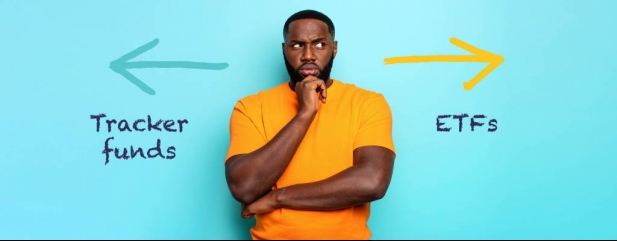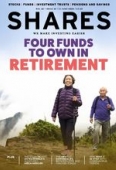Archived article
Please note that tax, investment, pension and ISA rules can change and the information and any views contained in this article may now be inaccurate.
Which should I choose, tracker funds or ETFs?

I’m fairly new to investing and have been looking to gain low-cost exposure to stocks. With this in mind could you explain which are the better option, ETFs or tracker funds?
Michael
Reporter Yoosof Farah replies:
On the surface they may seem like the same thing, but index tracker funds and exchange-traded funds (ETFs) are two distinct investment products with significant differences.
Both are typically used for passive investing, following an index like the FTSE 100 or S&P 500, and are also similar in that they offer a low-cost way of accessing the stock market.
But there are differences between the two which are important to know.
For starters ETFs are traded on a stock exchange like shares, and so are treated in the same way shares in companies and are priced throughout the day. A tracker fund is structured as a unit trust or open-ended investment company (OEIC), and priced once a day.
But as ETFs are treated like shares, this also means they are likely to incur higher dealing charges than if you were buying tracker funds, which have the same structure as regular active funds.
Tracker funds will also have different share classes for retail and institutional investors, with institutional share classes tending to be cheaper.
Tracker funds still dominate the passive landscape in the UK in terms of overall assets, partly as a legacy of ETFs having initially been more expensive five to 10 years ago, with the ETF market not as developed in the UK as it was in the US for example.
ETF COSTS HAVE FALLEN
However that has changed significantly over the last decade and often for individual investors, ETFs can have noticeably lower costs. Almost all new passive product launches now also tend to be ETFs, with thematic investments in particular tending to be launched as an ETF.
If you are looking to build a portfolio, ETFs could be a better option for several reasons.
The fact that ETFs have a single share class means there is more price competition, as providers have an incentive to bring costs down for everyone, whereas fund companies pulling in big amounts of money from institutional investors sometimes only need to cater to that audience.
In addition the tight bid/offer spread on ETFs, particularly the more popular ones, and the fact it is traded on an exchange means you have a pretty good idea how much you’re going to get when it comes to selling your ETF.
For index funds however it is less clear, given the once a day pricing and some of the opaque charges used by fund companies.
PRICING TRANSPARENCY
One pricing method commonly used is swing pricing, whereby a single price is issued for the fund and all clients buy and sell shares at this price.
This single price incorporates a swing in the net asset value (NAV) of the fund depending on whether there were net inflows or net outflows on that particular day. You won’t know until the next day how much you got for selling your holding.
But one thing to consider with ETFs is that there is no fractional trading. Say you want to invest £50 in an ETF but each share is priced at £100, there is no option to invest just the £50, you can only buy the shares for £100.
Units in funds on the other hand trade to four decimal places, meaning if you’re starting out by regularly investing £25 or £50 a month for example, you can potentially put that into any index fund you want, with lower dealing charges too.
Overall ETFs may be the better option rather than index funds for investors building a portfolio, but for those looking to switch from an index fund to an ETF, consider the cost of trading before you do so.
REAL-WORLD EXAMPLES
For some markets, switching from an index fund to an ETF can be a relatively straightforward decision. Take for example iShares Core FTSE 100 ETF (ISF) and Halifax UK FTSE 100 Index Tracking Fund (3181225).
Both do the same thing, yet the iShares one charges 0.07% a year and the Halifax one charges 1% a year. So if you wanted to invest £10,000 in the FTSE 100, iShares will take £7 a year from your investment and Halifax, for tracking the index like iShares, will take £100 a year from you. Picking between the two is not difficult.
Usually the bid/offer spread for ETFs tracking indices like the FTSE 100 tends to be between 0.03% 0.04%, but for areas like certain emerging markets or bonds for example this can increase to 0.3% to 0.4%, making the cost of switching significantly more expensive.
But for an investor looking to add passive investments to their portfolio, choosing ETFs over index funds can prove lower cost and provide greater choice, as well as more flexibility and transparency.
DO YOU HAVE ANY QUESTIONS ABOUT MARKETS AND INVESTING?
Let us know if we can help explain how something works or any other question relating to markets and investing. We’ll do our best to answer your question in a future edition of Shares.
Email editorial@sharesmagazine.co.uk with ‘Reader question’ in the subject line.
Please note, we only provide information and we do not provide financial advice. We cannot comment on individual stocks, bonds, investment trusts, ETFs or funds. If you’re unsure please consult a suitably qualified financial adviser.
Important information:
These articles are provided by Shares magazine which is published by AJ Bell Media, a part of AJ Bell. Shares is not written by AJ Bell.
Shares is provided for your general information and use and is not a personal recommendation to invest. It is not intended to be relied upon by you in making or not making any investment decisions. The investments referred to in these articles will not be suitable for all investors. If in doubt please seek appropriate independent financial advice.
Investors acting on the information in these articles do so at their own risk and AJ Bell Media and its staff do not accept liability for losses suffered by investors as a result of their investment decisions.

 magazine
magazine









